Anjō
Anjō (安城市, Anjō-shi) is a city in Aichi Prefecture, Japan. As of 1 October 2019, the city had an estimated population of 188,693 in 76,087 households,[1] and a population density of 2,193 persons per km². The total area of the city was 86.05 square kilometres (33.22 sq mi).
Anjō 安城市 | |
|---|---|
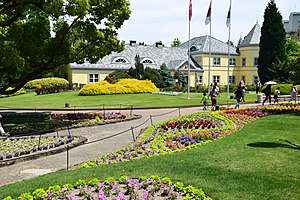  Upper stage: Den Park Lower stage: Skyline of Mikawaanjō | |
 Flag  Seal | |
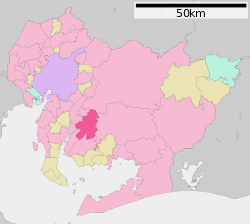 Location of Anjō within Aichi Prefecture | |
 Anjō | |
| Coordinates: 34°57′31.4″N 137°4′49.2″E | |
| Country | Japan |
| Region | Chūbu (Tōkai) |
| Prefecture | Aichi |
| Government | |
| • Mayor | Gaku Kamiya |
| Area | |
| • Total | 86.05 km2 (33.22 sq mi) |
| Elevation | 10 m (30 ft) |
| Population (October 1, 2019) | |
| • Total | 188,693 |
| • Density | 2,200/km2 (5,700/sq mi) |
| Time zone | UTC+9 (Japan Standard Time) |
| - Tree | Japanese Black Pine |
| - Flower | Scarlet Sage |
| Phone number | 0566-76-1111 |
| Address | 18-23 Sakuramachi, Anjō-shi, Aichi-ken 446-8501 |
| Website | Official website |
.jpg)

Geography
Anjō is situated in southern Aichi Prefecture, approximately 30 kilometres (19 mi) from central Nagoya, in the center of the Okazaki Plain, on the west bank of the Yahagi River. National Route 1 and National Route 23 provide the main east-west access through the city, with Aichi Prefectural Route 48 running between the two.
Demographics
Per Japanese census data,[2] the population of Anjō has grown rapidly over the past 70 years.
| Year | Pop. | ±% |
|---|---|---|
| 1940 | 46,737 | — |
| 1950 | 61,037 | +30.6% |
| 1960 | 66,793 | +9.4% |
| 1970 | 94,307 | +41.2% |
| 1980 | 123,843 | +31.3% |
| 1990 | 142,251 | +14.9% |
| 2000 | 158,824 | +11.7% |
| 2010 | 178,738 | +12.5% |
Climate
The city has a climate characterized by hot and humid summers, and relatively mild winters (Köppen climate classification Cfa). The average annual temperature in Anjō is 15.6 °C. The average annual rainfall is 1576 mm with September as the wettest month. The temperatures are highest on average in August, at around 27.7 °C, and lowest in January, at around 4.4 °C.[3]
History
The area of present-day Anjō has been continuously occupied since preshistoric times. Archaeologists have found numerous remains from the Japanese Paleolithic period and burial mounds from the Kofun period. During the Nara period, the area was assigned to ancient Hekikai County, and was divided into several shōen during the Heian period, largely under the control of the Fujiwara clan or the Taira clan. However, in the Kamakura period, parts of the territory came under the control of the Jōdo Shinshū sect, who challenged the secular authority of the various samurai clans, most notably the Matsudaira clan. During the Sengoku period, numerous fortifications were erected in the area. Tokugawa Ieyasu unified the region and destroyed the power of the Jōdo Shinshū sect in the Battle of Azukizaka (1564). During the Edo period, half of present-day Anjō was controlled by Okazaki Domain and the other half by Kariya Domain under the Tokugawa shogunate with some scattered portions of tenryō territory ruled directly by the shogunate. During this period, the area was noted for its production of cotton and textiles.
At the start of the Meiji period, on October 1, 1889, Anjō was one of a collection of villages organized within Hekikai District, Aichi Prefecture by the establishment of the modern municipalities system,. It was elevated to town status on May 1, 1906. The opening of the Meiji Irrigation Canal transformed the area in the 1920s and 1930s into one of the most agriculturally productive regions of the period, sparking the comparison with Denmark, then regarded the most highly advanced agricultural nation in the world.[4] This led to Anjō's moniker of "Japan's Denmark" (日本デンマーク), which remains in the form of Den Park, a Danish theme park, as well as Den Beer, a microbrew available in the park.
Anjō was elevated to city status on May 3, 1952. On April 1, 1967, it annexed the neighboring town of Sakura.
Government

Anjō has a mayor-council form of government with a directly elected mayor and a unicameral city legislature of 28 members. The city contributes two members to the Aichi Prefectural Assembly. In terms of national politics, the city is part of Aichi District 13 of the lower house of the Diet of Japan.
Economy
Anjō is a regional commercial center with a mixed economy of manufacturing and agriculture. In addition to rice, wheat, and soybeans, notable agricultural products include figs, Japanese pears, and cucumbers. Due to its proximity to the various factories of Toyota in neighboring Toyota City, Anjō is host to many factories supplying components into the automobile industry.
Companies headquartered in Anjō
- Makita, power tools, founded in Anjō, 1915.
- Aisin AW, automotive components
- Anden, automotive components
- Central Motor Wheel, automotive components
- Hekikai Shinkin Bank
- Sugi Holdings, pharmaceuticals
- Tosho Holdings, real estate
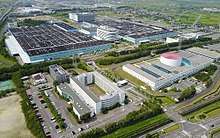 The headquarters of AISIN AW
The headquarters of AISIN AW Makita lawn mowers
Makita lawn mowers Sugi Pharmacy headquarters
Sugi Pharmacy headquarters Tosho Building
Tosho Building.jpg) Anforet main building
Anforet main building.jpg) Anforet outdoor plaza
Anforet outdoor plaza
Education
Schools
Primary and secondary education
- Anjō has 21 public elementary schools and eight public middle schools operated by the city government. The city has four public high schools operated by the Aichi Prefectural Board of Education. In addition the prefecture operates one special education school for the handicapped.
International schools
- Escola São Paulo – Brazilian school (Ensinos Fundamental e Médio)[5]
Professional development school
- Denso Technical Skills Academy
Transportation
Railway
The Tōkaidō Shinkansen stops at Mikawa-Anjō Station, but Anjō Station on the Tōkaidō Main Line and Shin-Anjō Station on the Meitetsu Nagoya Main Line and Nishio Line serve the commercial center of the city.
- Shin-Anjō
- Shin-Anjō • Kita-Anjō • Minami-Anjō • Hekikai-Furui • Horiuchi-Kōen • Sakurai • Minami-Sakurai •
Highways
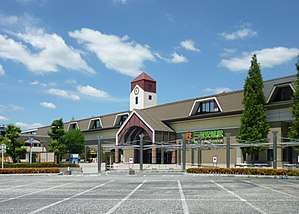

 Anjo Station
Anjo Station Cycling Road from Anjō to Toyota
Cycling Road from Anjō to Toyota
Sister cities

.svg.png)

Local attractions
Tourist attraction
- National Historic Sites
- Honshōji – Buddhist temple that was the site of the Battle of Azukizaka (1564)
- Futago Kofun
- Himeogawa Kofun
- Other historical sites
- Anjō Castle - Site of Anjo Castle, built in 1480, destroyed in 1562
- Anjō shrine
- Meijigawa Shrine
 Anjō Castle
Anjō Castle02.jpg) Honshōji temple
Honshōji temple- Anjō shrine
 Meijigawa Shrine
Meijigawa Shrine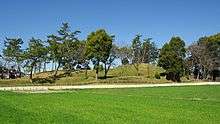 Futago Kofun
Futago Kofun
- Parks
- Den Park
- Horiuchi Park
 Den Park
Den Park- Horiuchi Park
Festival
- Anjo Tanabata Festival
Notable people
- Tohru Fukuyama, organic chemist
- Tam Nakano, professional wrestler
- Kazuchika Okada, professional wrestler
- Ayumi Tanimoto, Olympic gold-medalist judo wrestler
- Ryōka Yuzuki, voice actress
References
- Anjō City official statistics (in Japanese)
- Anjō population statistics
- Anjō climate data
- "Aichi Voice - The Denmark of Japan?"
- "Escolas Brasileiras Homologadas no Japão" (Archive). Embassy of Brazil in Tokyo. Retrieved on October 13, 2015. "Endereço: 1-3-4 Sasame-cho, Anjo-shi, Aichi-ken 446-0073"
- "International Exchange". List of Affiliation Partners within Prefectures. Council of Local Authorities for International Relations (CLAIR). Archived from the original on December 24, 2015. Retrieved November 21, 2015.